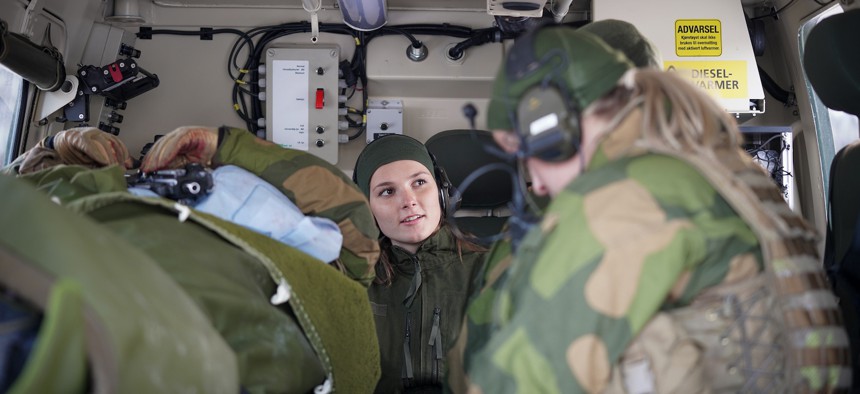
In this handout image provided by the Royal Court Of Norway, Princess Ingrid Alexandra visits the Army's Brigade North on October 25, 2022, in Setermoen, Norway. Simen Løvberg Sund - Handout / Getty Images
In Norway, young people compete to serve in the military
Other countries mulling wider national service plans should learn about the Norwegian model.
Princess Ingrid Alexandra of Norway has just begun a year of military service after qualifying for one of the country’s sought-after conscription slots. That’s right: even though military service is mandatory in Norway, the fact that it’s also highly selective has made it a prestigious assignment for Norwegian 18- and 19-year-olds. Countries considering reintroduction of military service would do well to adopt the Norwegian model—and to expand it to all parts of society that are critical to the nation’s security.
Her father, Crown Prince Haakon, was pleased when her imminent service—in an engineering battalion in northern Norway—was announced on Jan. 1.
“I myself have a defense background and have learned a lot from it and think it has been a good experience to have with me. So I hope it will be the same for her,” Haakon told Norwegian Public Broadcasting.
The princess, who is second in line to the throne, reported for duty two weeks later, joining some 9,900 other young Norwegians doing conscription each year. This year’s figure hasn’t yet been released, but last year 9,840 men and women were selected for military service. That’s a mere 17 percent of the children born in 2004, the cohort eligible for military service in 2023.
The Norwegian armed forces select the best candidates, first through online assessments and then through physical tests. For the 2023 conscription cohort, 24,600 men and women were selected for the physical tests, and from among them the final 9,840 were selected—36 percent of them women. Being accepted to military service in Norway is far harder than getting into most universities, and that turns military service from a dreary task everyone dreads to a prestigious assignment people compete to be selected for.
Norway’s selective military service began as an accident of history. When the Cold War ended, the armed forces didn’t need as many conscripts as before. Reducing the numbers had the same effect on interest that any rarity has: it suddenly made military service more attractive. And today, at a 17 percent acceptance rate, the armed forces indisputably get Norway’s best and brightest 19-year-olds, while the lucky 19-year-olds get a standout entry on their CV.
So successful is the program that about one-quarter of the conscripts opt for a career in the armed forces. Had they not been selected for military service, many of them would not have known they might want a future in the military. Conscription allows the armed forces to reach all parts of society more effectively than any clever advertising campaign. (I have written about this in a range of publications; see, for example, “Competitive National Service: How the Scandinavian Model Can Be Adapted by the UK,” published by RUSI in 2019.)
Now that other Western countries such as Germany are discussing reintroduction of military service, they would do well to learn from the Norwegians. Sweden already has: it suspended military service in 2010 and reinstated it eight years later using a model similar to Norway’s. With the exception of frontline states with small or very small populations, like Finland and Estonia, today Western countries don’t need mass armies. They do, however, need highly trained soldiers. Indeed, they also need well-trained citizens who can be part of national defense in other parts of society. Consider healthcare: when Covid struck, hospitals and care homes were quickly overwhelmed. Or critical national infrastructure: if, say, a pipeline, power plant or sanitation plant is struck by a cyber attack, the companies’ own employees are in no position to handle the chaos such a disruption generates. Just as the military can call up reservists in contingencies during crises (conscripts who don’t become professional soldiers join the reserves), other critical parts of society should be able to call on similar reserves. The UK has an organization, the First Aid Nursing Yeomanry, that deploys experts to contingencies, and the Scandinavian countries have Home Guards and auxiliary military organizations that take on some of these tasks—but not all. No Western country so far has full-fledged non-military national service. (In Denmark, conscripts can request assignment to the Danish Emergency Management Agency.)
Imagine the possibilities if every 18-year-old had the chance to be assessed for selective training with institutions ranging from the military to healthcare, power plants and water authorities. Like Norway’s conscription, such service would be a unique opportunity for every teenager to be assessed on their talent and aptitude, with educational background an irrelevant factor in the selection. If done well, national service is beneficial not just to the country but also to the individuals selected for it. Who wouldn’t want hard-to-attain professional qualifications in addition to the vaunted entry on their CV that identifies them as being one of their country’s top achievers?
National service also teaches its participants to get along with fellow soldiers of all kinds of backgrounds. It’s the ultimate social integrator. Countries shouldn’t launch national service solely to facilitate societal integration, but the fact that it happens naturally is an excellent side benefit of the intense teaching for which military service exists. Though Princess Ingrid Alexandra could conceivably have tried to get out of the selection process, she didn’t, because national service is the thing to do. Not just in Norway.


